Control and Coordination Class 10 Notes Science Chapter 6
| Table of contents |

|
| Introduction |

|
| Animals - Nervous System |

|
| Coordination in Plants |

|
| Hormones in Animals |

|
Introduction
Have you ever wondered what makes something alive? One of the easiest clues is movement. When we see a seed pushing its way through the soil or a cat chasing a mouse, we know they’re alive because they’re moving. But here’s the important part: not all movements are the same. Some happen because a plant or animal is growing, while others, like kids playing, aren’t about growth at all.
So, why do living things move? It’s all about reacting to what’s happening around them! Plants reach out to absorb up sunlight, and even when we whisper in class instead of shouting, we’re responding to what’s around us. These movements aren’t random – they’re carefully controlled to help living things survive and thrive. To do this, every living creature has special systems inside them that make sure they respond just the right way to what’s going on in their world.
- All living organisms respond and react to changes in the environment around them.
- The changes in the environment to which the organisms respond and react are called stimuli such as light, heat, cold, sound, smell, touch, etc.
- Both plants and animals respond to stimuli but in a different manner.
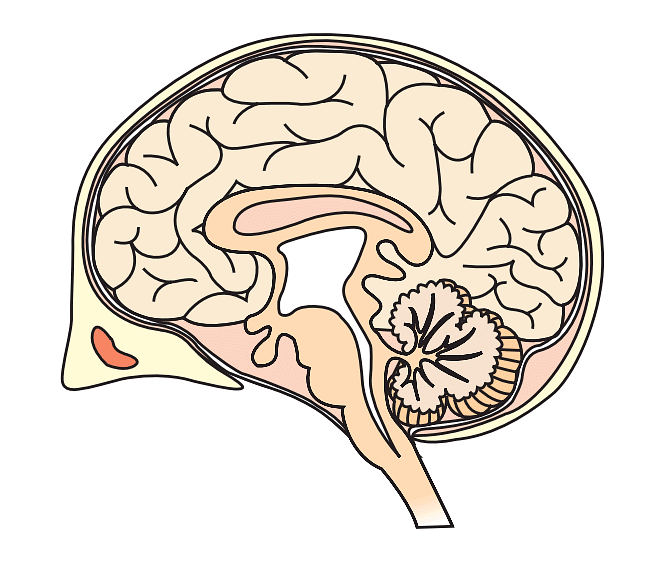 Control and Coordination
Control and Coordination
Animals - Nervous System
In animals, the nervous and muscular tissues are responsible for regulating and coordinating body functions. Our bodies have specialized cells called receptors, which act like tiny sensors at the ends of nerves to gather information from our surroundings. These receptors are mainly located in our sense organs—like the inner ear, nose, and tongue.
For Example:
- Gustatory Receptors: These receptors are found on the tongue and help us detect different tastes. For instance, they tell us whether something is sweet, sour, salty, or bitter.
- Olfactory Receptors: Located in the nose, these receptors pick up different smells. When you smell something like freshly baked cookies or a flower, these receptors send information to your brain about the scent.
The nervous system controls and coordinates bodily actions in animals. It consists of the brain, spinal cord, and a network of nerves. The system is responsible for sending, receiving, and processing impulses, which are chemical signals. Nerves extend from the brain and spinal cord, conveying messages throughout the body. Nervous tissues are organized around neurons and transmits information through electrical impulses. Neurons are the basic units. Parts of a neuron are: 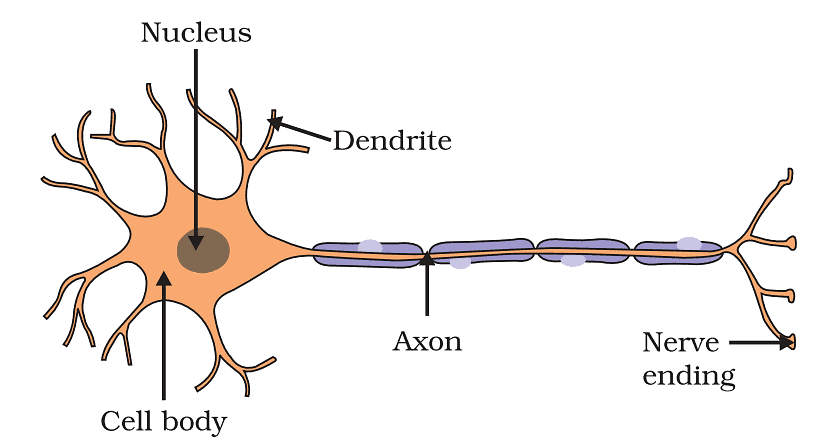 Neuron
Neuron
- Dendrites - These are the branch like structures that receive messages from other neurons and allows the transmission of messages to cell body.
- Cell Body- Each neuron has a cell body with a nucleus.
- Axon- It is a tube like structure that carries electrical impulse from cell body to the axon terminals
- Synapse- It is the chemical junction between axon of one neuron and dendrites of other neuron.
Neurons are of various shapes and sizes. Sensory nerves transmit messages from sense organs to the brain or spinal cord. Motor neurons convey messages from the brain or spinal cord to muscles and glands.
- When a nerve cell gets a signal at its tip, it creates an electrical signal that travels through the cell.
- This signal moves from the cell’s tip to the main part of the cell and then along the long part called the axon.
- At the end of the axon, the signal causes chemicals to be released.
- These chemicals cross a small gap and start a new signal in the next nerve cell.
- This process helps send messages through the body, including to muscles and glands.
Note: Nervous tissue is made up of a network of nerve cells that are specially built to send messages as electrical signals from one part of the body to another.
What Happens in Reflex Actions?
A reflex action is a quick and automatic reaction to something, like touching something hot.
For example: When you touch a hot object, you pull your hand back immediately without thinking about it. That’s a reflex action.
Reflex Arc
It is the shortest pathway for an impulse to travel from the receptor organ via central nervous system to the effector.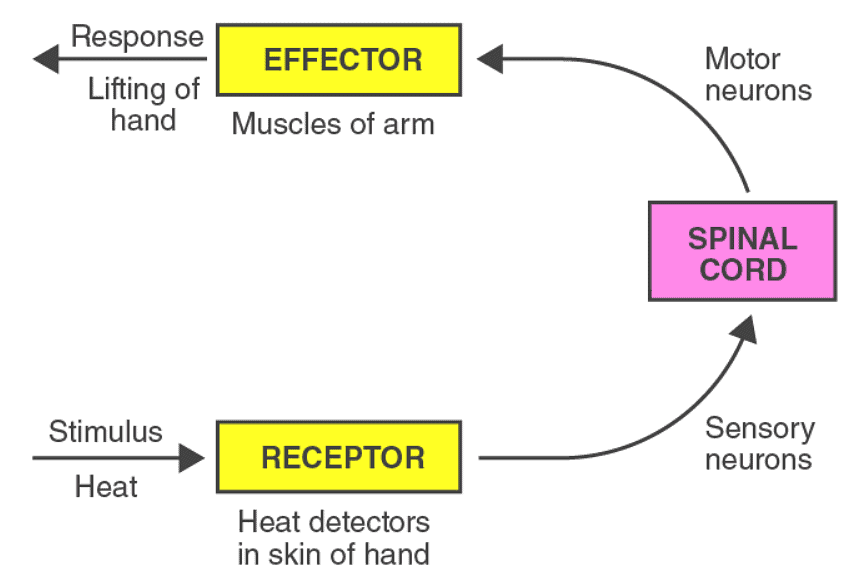 Reflex Arc flow
Reflex Arc flow
Components of the reflex arc:
- It includes one sensory neuron which transmits the sensory impulses from the receptors to the central nervous system.
- The sensory impulses are integrated in the central nervous system.
- The central nervous system transmits the motor information to the effector via the motor neurons.
- The effector produces the desired response to the stimulus.
 Reflex Arc
Reflex Arc
Human Brain
Types of Nervous System: Types of Nervous System
Types of Nervous System
1. Central Nervous System (CNS)
It comprises of the brain and spinal cord. Major function of CNS is that it receives data from the body and sends instructions to specific organs.
The brain has three major regions: forebrain, midbrain, and hindbrain.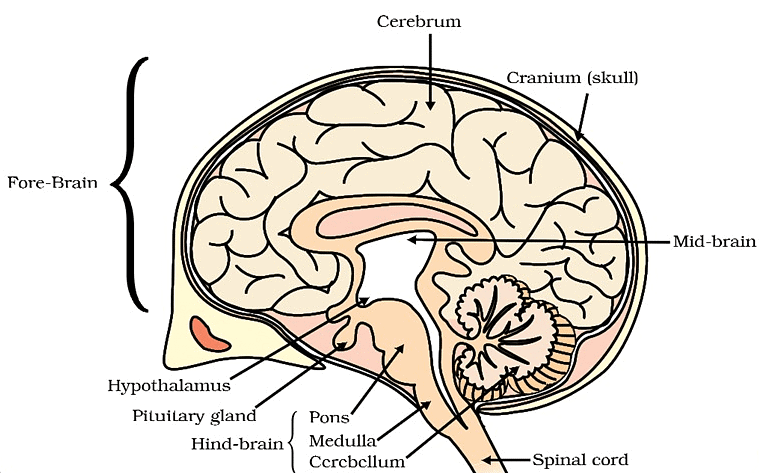 Parts of Brain
Parts of Brain
Let us understand the brain in detail:
a) Fore-brain: It is the most complex or specialized part of the brain. It consists of the cerebrum.
Functions of Fore-brain:
- Thinking part of the brain.
- Control the voluntary actions.
- Store information (Memory).
- Receives sensory impulses from various parts of the body and integrates it.
- Centre associated with hunger.
b )Mid-brain: Controls involuntary actions such as a change in pupil size and reflex movements of the head, neck, and trunk.
c) Hind-brain: It has three parts:
- Cerebellum: Controls posture and balance. Precision of voluntary actions. Example: picking a pen.
- Medulla: Controls involuntary actions. Example: blood pressure, salivation, vomiting.
- Pons: Involuntary actions, regulation of respiration.
Protection of the Brain and Spinal Cord
- Protection of Brain: The brain is protected by a fluid-filled balloon that acts as shock absorber and is enclosed in cranium (skull or brain box).
- Protection of Spinal Cord: Spinal cord is enclosed in vertebral column.
2. Peripheral Nervous System (PNS)
- Involves cranial and spinal nerves emerging from the brain and spinal cord.
- Forms a network outside the CNS.
How are these Tissues protected?
The brain, crucial for various activities, requires careful protection. The body is designed with a bony box to safeguard the delicate organ. 
- Fluid-Filled Protection: Inside the protective box, the brain is surrounded by a fluid-filled balloon for additional shock absorption.
- Vertebral Column: Running your hand down the back reveals the vertebral column or backbone.
- Spinal Cord Protection: The vertebral column safeguards the spinal cord, providing essential protection to this vital neural pathway.
- Spinal Cord: The spinal cord plays a crucial role in transmitting sensory information to the brain and relaying messages from the brain to the muscles. It is an essential component of the nervous system, working in conjunction with the brain to coordinate various bodily functions and enable voluntary actions.
How does the Nervous Tissue cause Action?
(i) Nerve Impulse Transmission:
- Nervous tissue collects and processes information.
- A nerve impulse is sent from the nervous system to the muscle.
(ii) Muscle Activation:
- The nerve impulse reaches the muscle.
- Muscle fibers respond by changing their shape, causing them to shorten.
(iii) Protein Interaction:
- Muscle cells contain special proteins that change their shape and arrangement in response to the nerve impulse. This change causes the muscle to contract.
Coordination in Plants
Plants don't have a nervous system or muscles like animals, so how do they respond to stimuli? For example, when we touch the leaves of a 'sensitive' plant, they quickly fold up. In contrast, the growth of a seedling leads to directional movement. It's important to note that the movement in the sensitive plant is not related to growth, whereas the seedling's movement depends on its growth. This distinction highlights that plants exhibit two types of movement: one tied to growth and the other not linked to growth.
Immediate Response to Stimulus
When thinking about the movement of plants like sensitive plants, it's essential to understand that this movement doesn't involve growth. Despite the absence of nervous or muscle tissue, the plant can move its leaves when touched.

- The challenge is understanding how the plant detects touch and facilitates leaf movement.
- Movement occurs at a point different from the actual touch location, indicating that some form of communication about the touch is happening.
- Unlike animals, plants use electrical-chemical signals to convey information between cells.
- Unlike animals, there is no specific tissue in plants designed for information conduction.
- Similar to animals, certain cells in plants must change shape for movement to occur.
- Plant cells achieve shape changes by adjusting water content, causing swelling or shrinking and resulting in altered shapes.
 Response to Stimuli Related to Growth
Response to Stimuli Related to Growth - Tropic movements are also known as directional movements. These movements can be either toward or away from the stimuli.
- Shoots that respond to light by bending towards it are said to have positive phototropism. Shoots that grow away from the earth show negative geotropism.
- Negative phototropism occurs when roots bend away from light. They demonstrate positive geotropism as they grow towards the ground.
Movement Due to Growth
There are two types of movements in plants.- Independent of growth
- Dependent on growth
1. Independent of growth
- Independent growth has an immediate response to the stimulus.
- Plants use electrical-chemical means to convey information from cell to cell.
- For movement to happen, cells change their shape by changing the amount of water in them, resulting in swelling or shrinking of cells.
Example: Drooping of leaves of ‘Touch-me-not’ plant on touching it.
2. Dependent on growth
These movements are tropic movements i.e., directional movements in response to stimulus.
- Tendrils: The part of the tendril away from the object grows more rapidly as compared to the part near the object. This causes the circulating of tendrils around the object.
- Phototropism: Movement towards light.
- Geotropism: Movement towards/away from gravity.
- Chemotropism: Growth of pollen tube towards ovule.
- Hydrotropism: Movement towards water.
How information is communicated in the bodies of multicellular organisms?
Electrical impulses are a way for cells to communicate with each other, but they have limitations. These impulses can only reach cells connected by nerve tissue and not every cell in the body. Additionally, once a cell sends an impulse, it needs time to reset before sending another one. Because of this, most multicellular organisms use chemical signals for communication.
Limitations of Electrical Impulses:
- Electrical impulses can only reach cells connected by nerve tissue.
- Cells need time to reset after sending an impulse before sending another.
When cells release a chemical instead of an electrical signal, that chemical can spread around the cell. If nearby cells can detect this chemical using special molecules on their surfaces, they can understand and pass on this information.
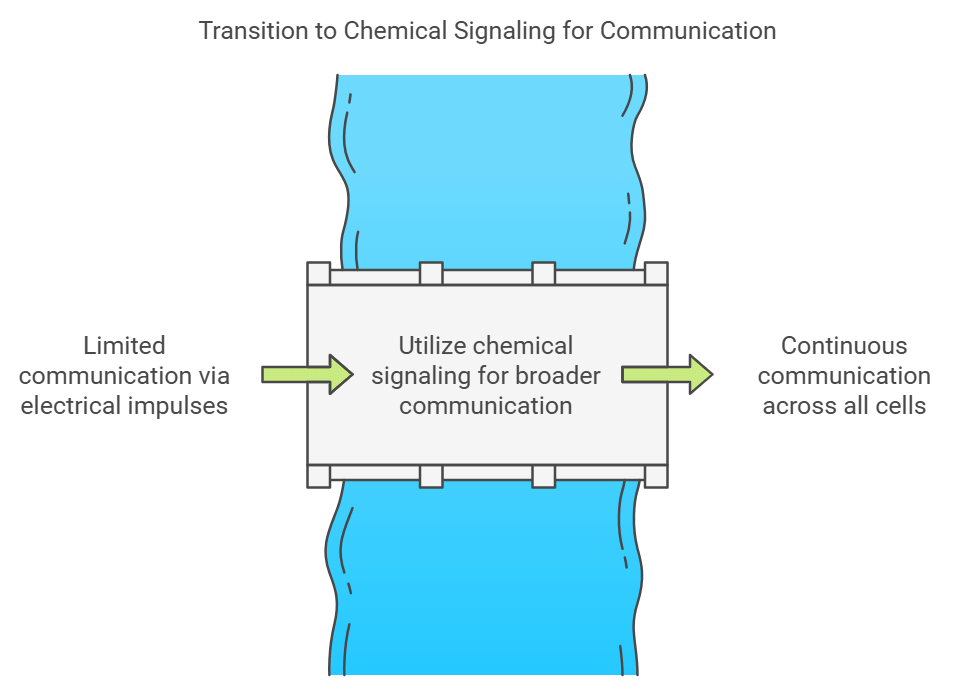 Although this process is slower than electrical impulses, it can reach all parts of the body, not just connected by nerves, and can be continuous. In multicellular organisms, various compounds called hormones are used for control and coordination, showing a lot of variety. Plant hormones, for example, help in coordinating growth, development, and responses to the environment. These hormones are produced in one place but travel to where they are needed.
Although this process is slower than electrical impulses, it can reach all parts of the body, not just connected by nerves, and can be continuous. In multicellular organisms, various compounds called hormones are used for control and coordination, showing a lot of variety. Plant hormones, for example, help in coordinating growth, development, and responses to the environment. These hormones are produced in one place but travel to where they are needed.
- Cells can communicate by releasing chemicals that can be detected by other cells nearby through specific molecules on their surfaces.
- This chemical signaling is slower than electrical impulses but can reach all cells in the body and provide continuous communication.
- Hormones, which are chemicals used for control and coordination in multicellular organisms, come in various types to serve different functions.
- Plant hormones, for instance, help in managing growth, development, and responses to the environment by traveling from where they are produced to where they are needed.
Plant Hormones
These are chemical compounds which help to coordinate growth, development and responses to the environment.
Main plant hormones are:
- Auxin: This hormones synthesized at shoot tip. It helps the cells to grow longer and involved in phototropism (response towards light).
- Gibberellin: It helps in the growth of the stem.
- Cytokinins: It promotes cell division. This is present in greater concentration in fruits and seeds
- Abscisic Acid: It inhibits growth. It also cause wilting of leaves and also known as stress hormone.
 Plant Hormones
Plant Hormones
Hormones in Animals
Endocrine System: The endocrine system is composed of several endocrine glands. A ductless gland is called an endocrine gland. The endocrine gland secretes its product directly into the bloodstream. Hormones are produced in the endocrine glands. Hormone is mainly composed of protein. Hormones assist the nervous system in control and coordination. The nervous do not react to every nook and corner of the body and hence hormones are needed to affect control and coordination in those parts. Moreover, unlike nervous control, hormonal control is somewhat slower.
Exocrine Gland: Exocrine glands are glands that discharge secretions using ducts, which open onto an epithelial surface.
Hormones: These are the chemical messengers secreted in very small amounts by specialised tissues called ductless glands. They act on target tissues/organs usually away from their source. Endocrine System helps in control and coordination through chemical compounds called hormones.
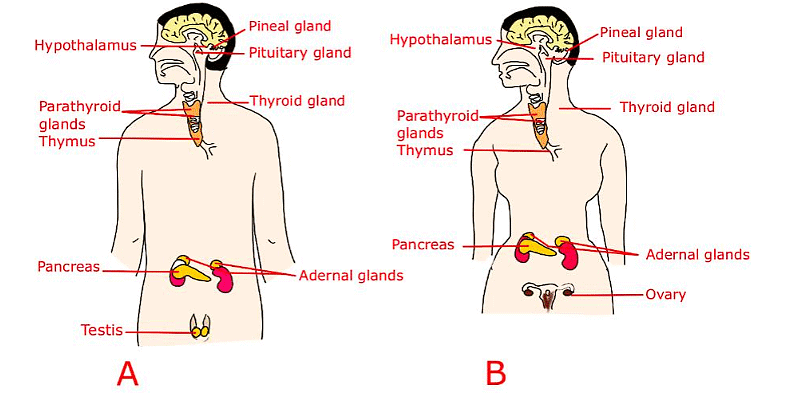 IEndoc rine Glands in (a) Male (b) Female
IEndoc rine Glands in (a) Male (b) Female
The list of endocrine gland with the hormones names and their functions are given below:
1. Pituitary gland
- It is a pea-sized gland located at the base of the brain.
- It is the master gland, as it controls the secretions of all the other endocrine glands.
- It also secretes Growth Hormone (GH).
- Under-secretion of GH causes Dwarfism, and over-secretion causes Gigantism in children.
2. Thyroid Gland:
- It is a butterfly-shaped gland located in the throat.
- It secretes the hormone ‘Thyroxine’, which regulates the metabolism of the body.
- Iodine is required to synthesize thyroxine in the body.
- In the case of iodine deficiency, under-secretion of thyroxine leads to goitre
3. Pancreas:
- It is a leaf-like gland present behind the stomach in the abdomen.
- It is an endocrine as well an exocrine gland.
- As an endocrine gland, it manufactures two hormones – Insulin and glucagon.
- Both these hormones act antagonistically and regulate the sugar level in the blood.
- As an exocrine gland, it secretes enzymes to break down the proteins, lipids, carbohydrates and nucleic acids in food.
- An insufficient amount of insulin from the pancreas leads to diabetes.
4. Adrenal Gland:
- Occurs in pairs above each kidney.
- It decreases in size with age.
- Secrets the hormone adrenaline, which helps in flight and fight response.
5. Gonads:
- Gonads are the gamete-producing organs – testes in males and ovaries in females.
- The testes produce the male hormone testosterone, and the ovaries produce the female hormones oestrogen and progesterone.
- Testosterone and oestrogen help in producing gametes and are responsible for the sexual characteristics of males and females, respectively.
- Progesterone is the pregnancy hormone.
Lets go through some other endocrine hormones briefly :
1. Pineal Gland
- Location: Towards the center of the brain, dorsal to the diencephalon.
- Hormone: Melatonin.
- Functions: Impacts reproductive development, sleep patterns, and seasonal functions.
2. Hypothalamus
- Location: Neuro-endocrine region connecting the nervous and endocrine systems.
- Connection: Links to the pituitary gland.
- Hormones: Somatostatin and Dopamine.
3. Parathyroid Glands
- Location: Two pairs on the dorsal surface of the thyroid gland in the neck.
- Hormone: Parathormone.
- Functions: Controls calcium and phosphate ion levels in bones and blood.
- Disorders: Tetany (hyposecretion), Osteoporosis (hypersecretion).
4. Thymus Gland
- Location: Upper region of the sternum, in front of the heart.
- Hormone: Thymosin.
- Function: Aids in the maturation of T-lymphocytes.
 Hormones in Animals and their Function
Hormones in Animals and their Function
Feedback Mechanisms
If we want our bodies to release just the right amount of hormones, there needs to be a way to make sure this happens correctly.
(i) The levels and timing of hormone release are controlled by feedback systems.
Importance of adequate Hormone Secretion:
- When our bodies release hormones, they must do so in exact amounts.
- Regulation by Feedback Mechanisms:
- Our bodies have systems that monitor and adjust hormone release based on what's happening inside us.
Example with Blood Sugar Levels:
- When our blood sugar levels rise, special cells in the pancreas sense this change.
- In response, the pancreas starts making more insulin.
- As blood sugar levels fall back to normal, the pancreas reduces the amount of insulin it produces.
Example: Pancreatic cells respond to rising blood sugar levels by producing more insulin; insulin secretion decreases when blood sugar levels fall.
|
80 videos|569 docs|80 tests
|
FAQs on Control and Coordination Class 10 Notes Science Chapter 6
| 1. What is the role of the nervous system in animals? |  |
| 2. How do plants coordinate their responses to stimuli? |  |
| 3. What are the main hormones involved in animal coordination? |  |
| 4. How do nerve impulses travel in the nervous system? |  |
| 5. What is the significance of hormones in plant growth and development? |  |
















